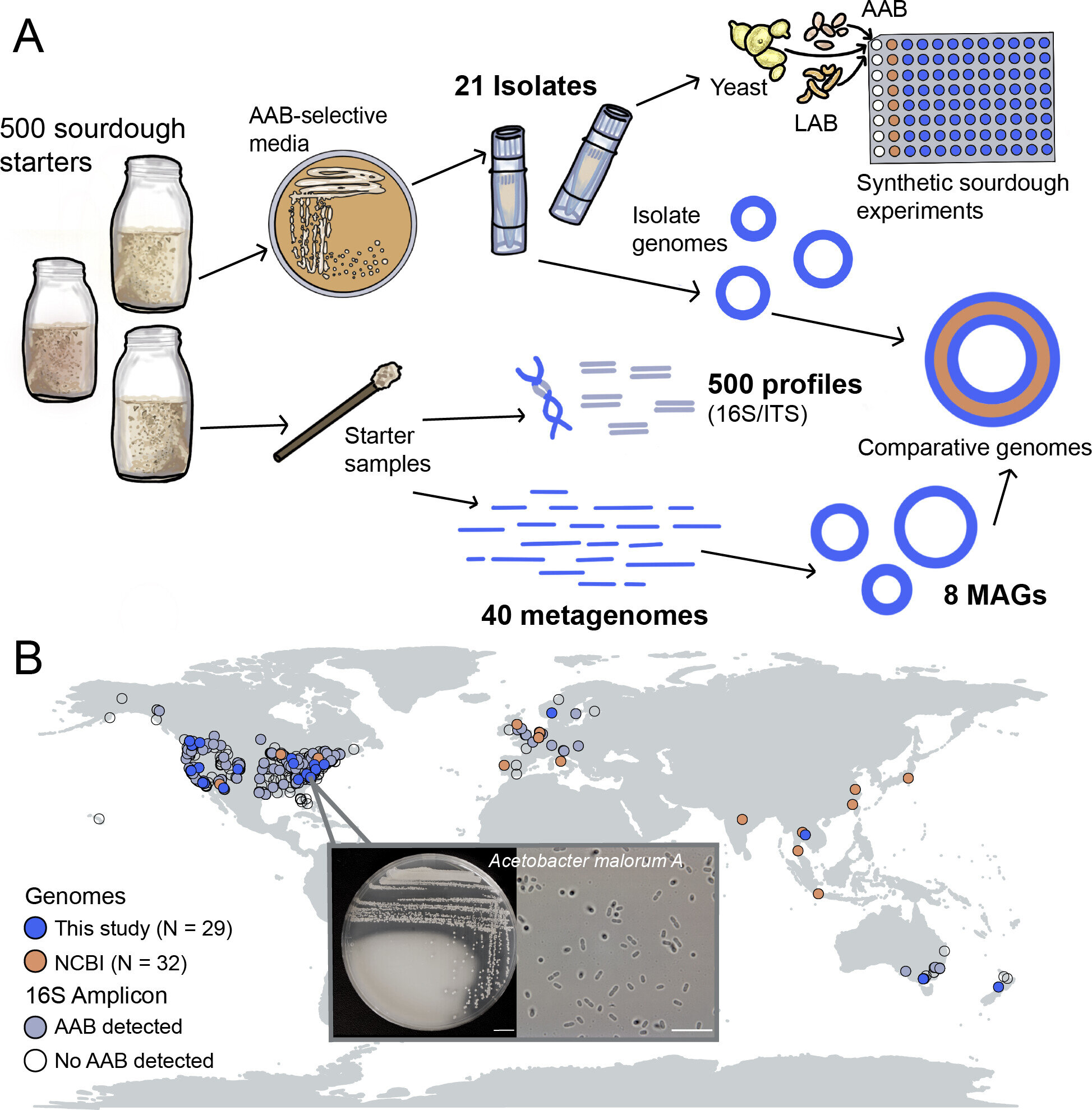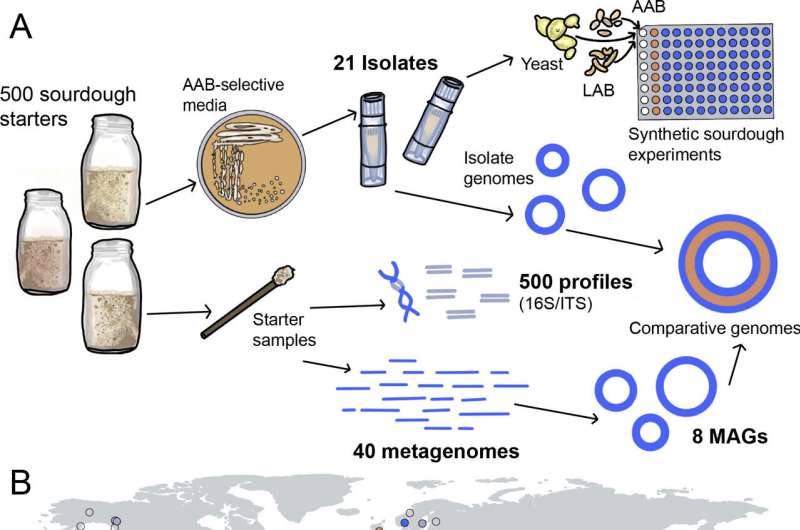

When millions of people went into lockdown during the pandemic, they went in search of new at-home hobbies to help cure their boredom. Among them was making sourdough bread. In addition to being sustainable for its use of natural ingredients and traditional methods which date back thousands of years to ancient Egypt, it is also valued for its nutritional benefits.
For example, studies have shown that sourdough contains more vitamins, minerals and antioxidants compared to many other types of bread. For people with mild sensitivities to gluten, sourdough bread can be easier to digest since much of the gluten is broken down during the fermentation process. What’s more, many lactic acid bacteria species, which are foundational to sourdough, are considered probiotics, associated with improved gastrointestinal health.
A flavor profile years in the making
The process of making sourdough bread begins with a sourdough starter. These starters are created when microbes—communities of bacteria and yeast—stabilize in a flour and water mixture. Known as a microbiome, this community of wild yeast and bacteria is what makes sourdough bread rise and contributes to its taste and texture. Sourdough notably differs from most bread because it relies on this starter of wild microbes to help it rise instead of baker’s yeast packets.
Many sourdough starters are preserved over generations, with some samples dating back thousands of years. To maintain a sourdough starter, you extract a sample from a previous dough and mix it into new flour and water. With enough transfers of the sourdough starter, the microbial community will be composed of the yeast, lactic acid bacteria (LAB), and acetic acid bacteria (AAB) that are best adapted to the sourdough environment. What makes different sourdough starters unique are the varying strains of yeast and bacteria that produce the distinctive sour flavor.
Testing genetic diversity
Advances in sequencing technology have enabled researchers to rapidly profile microbial communities, such as the sourdough microbiome. At Syracuse University, members of biology professor Angela Oliverio’s lab have been studying acetic acid bacteria to determine how the genetic diversity of AAB impacts sourdough communities.
While previous research has focused more on lactic acid bacteria and yeast, the ecology, genomic diversity, and functional contributions of AAB in sourdough remain largely unknown. Beryl Rappaport, a Ph.D. student in Oliverio’s group, recently led a study published in mSystems, in which she and other sourdough scientists, including Oliverio, Nimshika Senewiratne from the Oliverio lab, SU biology professor Sarah Lucas, and professor Ben Wolfe from Tufts University, sequenced 29 AAB genomes from a collection of over 500 sourdough starters and constructed synthetic starter communities in the lab to define the ways in which AAB shape emergent properties of sourdough.
“While not as common in sourdough as lactic acid bacteria, acetic acid bacteria are better known for their dominant roles in other fermented foods like vinegar and kombucha,” says Rappaport. “For this study, we were interested in following up on previous findings which stated that when present in sourdough, AAB seems to have a strong impact on key properties including scent profile and metabolite production, which shape overall flavor formation.”
To assess the consequences of AAB on the emergent function of sourdough starter microbiomes, their team tested 10 strains of AAB, some distantly related and some very closely related. They set up manipulative experiments with these 10 strains, adding each one to a community of yeast and LAB. They kept a separate community of just yeast and LAB to serve as the control.
“Since we can manipulate what microbes and what concentrations of microbes go into these synthetic sourdough communities, we could see the direct effects of adding each strain of AAB to sourdough,” says Rappaport. “As we expected, every strain of AAB lowered the pH of the synthetic sourdough (associated with increasing sourness) since they release acetic acid and other acids as byproducts of their metabolic processes. Unexpectedly, however, AAB that were more closely related did not release more similar compounds. In fact, there was high variation in metabolites, many related to flavor formation, even between strains of the same species.”
According to Rappaport, strain diversity is often overlooked in microbial communities, in part because it is difficult to identify and manipulate levels of diversity due to the vastness of microorganisms within a given community. The human gut biome alone can have roughly 100 trillion bacteria living in it. By zooming into the diversity among closer relatives in the lab, researchers can start to understand key interactions in microbiomes.
A new starter source
When it comes to baking, she says their findings offer bread makers a new direction to shape sourdough flavor and texture.
“Since AAB reliably acidified the starters we worked with and released a large variety of flavor compounds, bakers who want their sourdough to be more sour or to create new flavors may try sourcing a starter with AAB or attempt to capture AAB themselves,” says Rappaport. “We hope that this study helps to shine a light on the diversity of microbes found in sourdough and their important functional roles.”
Their research could also have implications for the health benefits of sourdough bread.
During the fermentation process, AAB generates acetic acid, which significantly aids in breaking down gluten and complex carbohydrates, enhancing the digestibility of sourdough. By examining the genetic diversity of AAB and its influence on acetic acid production, researchers can develop strains that optimize this process.
The broader impact
The team uses sourdough primarily for its use as a model system because the sourdough microbiome is relatively simple to culture and use for repeated experiments in the lab. But their results stretch far beyond baking.
“Our findings will be relevant to people interested in more complex microbial communities, like the human gut or soil,” says Rappaport. This is because the sourdough system can be used to ask questions about ecology and evolution which would be more difficult to ask with more complex systems.
When it comes to the human gut, microbial communities can help build resilience to infections and improve efficiency in breaking down complex carbohydrates, fiber, proteins and fats. In the case of soil, microbes help to break down organic matter and maintain overall soil ecosystem stability. There are many unknowns, however, about how multiple levels of genetic diversity impact these processes.
By recognizing how strain diversity can have community-wide consequences on a microbiome, the team’s insights could have wide-ranging benefits for human health, wellness and environmental sustainability.
More information:
H. B. Rappaport et al, Genomics and synthetic community experiments uncover the key metabolic roles of acetic acid bacteria in sourdough starter microbiomes, mSystems (2024). DOI: 10.1128/msystems.00537-24
Provided by
Syracuse University
Citation:
Scientists explore microbial diversity in sourdough starters (2024, October 1)
retrieved 2 October 2024
from https://phys.org/news/2024-10-scientists-explore-microbial-diversity-sourdough.html
This document is subject to copyright. Apart from any fair dealing for the purpose of private study or research, no
part may be reproduced without the written permission. The content is provided for information purposes only.